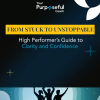
“I’m not ready. What if I fail?”
That’s what my client told me—calmly, but with the unmistakable undertone of hesitation. She was standing on the edge of something big.
On one side: the steady, mid-level role she had comfortably grown into. She knew the people, the pace, the expectations.
On the other: a bold opportunity to lead a function from scratch at a scaling startup. More responsibility. More visibility. More unknowns.
“This is what I’ve been working toward,” she said. “But I keep thinking… what if I mess it up?”
We paused. I asked, “Whose voice is that?”
“I think it’s mine. It feels like mine.” She said, almost apologetically. But as we explored deeper, she realized it wasn’t the voice of her present self. It was the voice of self-protection—a well-worn pattern trying to keep her safe.
The Brain Doesn’t Care About Growth—It Cares About Safety
From a neuroscience perspective, this reaction is completely normal.
The amygdala, our brain’s fear-response center, is built to detect threats. Unfortunately, it doesn’t distinguish between a lion chasing you and the discomfort of leading a new team or pitching a bold idea.
To your brain, uncertainty = danger. And it responds accordingly—with thoughts like:
- “You’re not ready.”
- “You need more time.”
- “Better to stay where it’s safe.”
These thoughts aren’t evidence. They’re protection mechanisms, designed to keep you from stepping outside the known.
Not Every Thought Is True
What my client—and many high achievers—struggle with is mistaking their thoughts for truth.
They assume their inner commentary is a compass. But not every thought is helpful. Not every fear is based in reality. Not every voice in your head deserves your leadership.
“You are not your thoughts. You are the one who notices them.”
That’s the shift. And it changes everything.
Because once you realize your thoughts are just mental weather—passing through—you can stop reacting to every cloud. You can start responding from a place of clarity.
A Practice for Leading Beyond Fear
Here’s how we worked with this insight, and how you can too:
- Name the thought — Instead of resisting it or trying to “be more confident,” just acknowledge what’s there.
- Ask: Is this helpful or just habitual? — Many doubts are reruns. You don’t need to watch the same show again.
- Ground in your intention — Reconnect with the version of you who said yes to growth in the first place.
- Respond from your future self — Not from fear, but from the leader you’re becoming.
- Let the thought pass — Just like a cloud. Don’t hold it. Don’t fight it. Just let it move through.
This practice isn’t about forcing yourself into action. It’s about creating space. Space between the stimulus and your response. Space to choose.
Confidence Is Built Through Action—Not Before It
In the end, my client said yes to the startup role.
Not because the fear magically disappeared. But because she no longer assumed that fear meant she was unprepared.
She didn’t feel perfectly ready. But she had practiced leading herself through the discomfort.
And that’s what real confidence looks like. Not the absence of doubt—but the ability to move through it.
Pin this thought
Your brain’s job is to protect you. But your job is to lead you.
And leadership often starts not with louder thoughts… but with quieter awareness.
So the next time your mind says, “I’m not ready,” pause and ask: Is this fear—or is this feedback?
Then decide who’s leading: your thoughts… or you.
I’d love to hear from you:
- What’s one thought that’s been keeping you in your comfort zone?
- What might shift if you stopped believing it by default?
Share your reflections in the comments.
🔔 Follow Anshuma Arora Mukkamala, ACC for grounded coaching tools to help you lead with more clarity, calm, and inner conviction.




